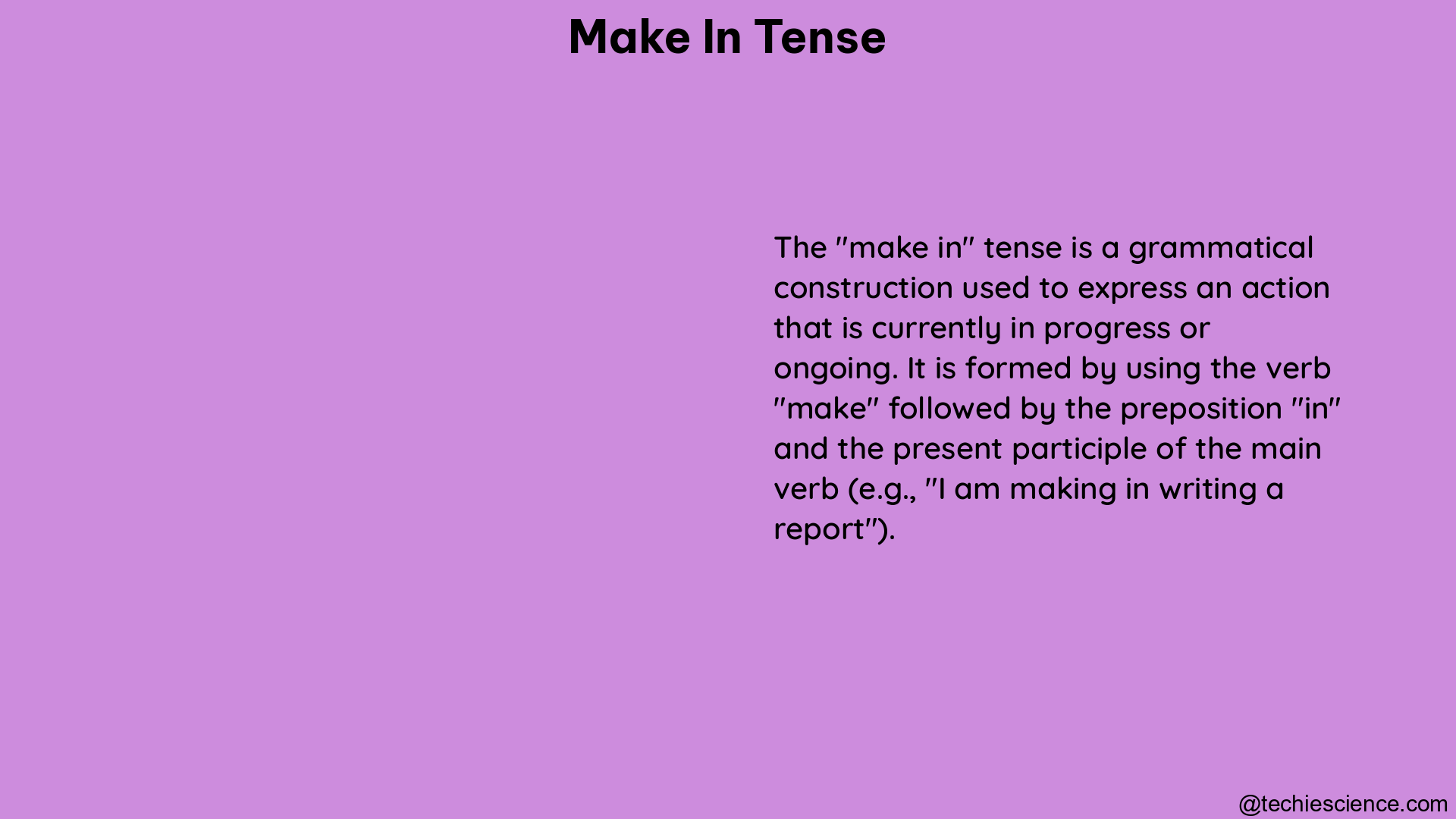The verb “make” is an essential and versatile word in the English language, but its conjugation can be tricky due to its irregular nature. This comprehensive guide will take you through the intricate details of using “make” in various tenses, providing you with a deep understanding of its grammar and usage.
Present Tense
In the present tense, the verb “make” follows the following patterns:
- I/you/we/they make: “I make tea every morning.”
- he/she/it makes: “She makes breakfast for her family.”
The key distinction is that the third-person singular (he/she/it) takes the “-s” ending, while all other subjects (I/you/we/they) use the base form of the verb.
Past Tense

The past tense of “make” is formed as follows:
- I/you/he/she/it/we/they made: “I made a cake for the party.”
The past tense form is the same for all subjects, using the irregular verb “made.”
Past Participle
The past participle of “make” is also “made”:
- made: “The cake has been made by my sister.”
This form is used in perfect tenses and the passive voice.
Future Tense
To express the future tense, we use the modal verb “will” with the base form of “make”:
- I/you/he/she/it/we/they will make: “I will make dinner tonight.”
Future Perfect Tense
The future perfect tense indicates an action that will be completed before a certain point in the future. The structure is “will have + past participle”:
- I/you/he/she/it/we/they will have made: “I will have made three cakes by the end of the week.”
Present Continuous Tense
The present continuous tense describes an ongoing action in the present. The structure is “to be + verb-ing”:
- I am making: “I am making a sandwich.”
- you are making: “You are making a lot of noise.”
- he/she/it is making: “She is making a dress.”
- we are making: “We are making progress.”
- they are making: “They are making a movie.”
Present Perfect Tense
The present perfect tense indicates an action that has been completed in the past, with a connection to the present. The structure is “have/has + past participle”:
- I have made: “I have made a lot of friends.”
- you have made: “You have made a big mistake.”
- he/she/it has made: “She has made a beautiful painting.”
- we have made: “We have made a lot of money.”
- they have made: “They have made a new discovery.”
Past Continuous Tense
The past continuous tense describes an ongoing action in the past. The structure is “to be + verb-ing” in the past tense:
- I was making: “I was making a cake when the doorbell rang.”
- you were making: “You were making a lot of noise.”
- he/she/it was making: “She was making a dress.”
- we were making: “We were making progress.”
- they were making: “They were making a movie.”
Past Perfect Tense
The past perfect tense indicates an action that was completed before another past action. The structure is “had + past participle”:
- I had made: “I had made a cake before the party started.”
- you had made: “You had made a big mistake.”
- he/she/it had made: “She had made a beautiful painting.”
- we had made: “We had made a lot of money.”
- they had made: “They had made a new discovery.”
Future Continuous Tense
The future continuous tense describes an ongoing action in the future. The structure is “will be + verb-ing”:
- I will be making: “I will be making a sandwich at 5 pm.”
- you will be making: “You will be making a lot of noise.”
- he/she/it will be making: “She will be making a dress.”
- we will be making: “We will be making progress.”
- they will be making: “They will be making a movie.”
Future Perfect Continuous Tense
The future perfect continuous tense indicates an action that will be ongoing until a certain point in the future. The structure is “will have been + verb-ing”:
- I will have been making: “I will have been making cakes for three hours.”
- you will have been making: “You will have been making a lot of noise.”
- he/she/it will have been making: “She will have been making a dress.”
- we will have been making: “We will have been making progress.”
- they will have been making: “They will have been making a movie.”
Past Perfect Continuous Tense
The past perfect continuous tense describes an ongoing action that was in progress before another past action. The structure is “had been + verb-ing”:
- I had been making: “I had been making a cake for two hours.”
- you had been making: “You had been making a lot of noise.”
- he/she/it had been making: “She had been making a dress.”
- we had been making: “We had been making progress.”
- they had been making: “They had been making a movie.”
Future Perfect Continuous Tense
The future perfect continuous tense indicates an action that will be ongoing until a certain point in the future. The structure is “will have been + verb-ing”:
- I will have been making: “I will have been making cakes for three hours.”
- you will have been making: “You will have been making a lot of noise.”
- he/she/it will have been making: “She will have been making a dress.”
- we will have been making: “We will have been making progress.”
- they will have been making: “They will have been making a movie.”
Passive Voice
The passive voice can be used with the verb “make” in various tenses. Here are some examples:
- Present Simple: “Tea is made for breakfast every morning.”
- Present Continuous: “Tea is being made for breakfast every morning.”
- Present Perfect: “Tea has been made for breakfast every morning.”
- Past Simple: “Tea was made for breakfast every morning.”
- Past Continuous: “Tea was being made for breakfast every morning.”
- Past Perfect: “Tea had been made for breakfast every morning.”
- Future Simple: “Tea will be made for breakfast every morning.”
- Future Continuous: “Tea will be being made for breakfast every morning.”
- Future Perfect: “Tea will have been made for breakfast every morning.”
Examples
Here are some examples of using “make” in different tenses:
- Simple Present: “I make tea every morning.”
- Present Continuous: “I am making a sandwich.”
- Present Perfect: “I have made a lot of friends.”
- Past Simple: “I made a cake for the party.”
- Past Continuous: “I was making a cake when the doorbell rang.”
- Past Perfect: “I had made a cake before the party started.”
- Future Simple: “I will make dinner tonight.”
- Future Continuous: “I will be making a sandwich at 5 pm.”
- Future Perfect: “I will have made three cakes by the end of the week.”
References
- WordReference.com. (n.d.). Conjugation of make – WordReference.com. Retrieved from https://www.wordreference.com/conj/enverbs.aspx?v=make
- Bab.la. (n.d.). Conjugate “to make” – English – Bab.la. Retrieved from https://en.bab.la/conjugation/english/make
- ThoughtCo. (2020, January 21). Conjugations and Sample Sentences: Irregular English Verb “Make”. Retrieved from https://www.thoughtco.com/how-to-conjugate-make-4570922

Hi…. I am Goutam Datta. I have completed a double M. A. in English and B. Ed. I am a creative writer. Currently, I am a part of the LambdaGeeks.